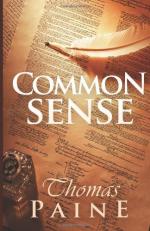|
This section contains 525 words (approx. 2 pages at 400 words per page) |

|
The American Revolution
Paine's writings entered an already-charged political environment. The British colonies were in direct conflict with their parent-country, Great Britain, over their own governing. Some colonies were more affected by restrictive British laws than others, and those most affected began protesting their treatment. Most famously, protesters in Boston staged the "Tea Party" in 1773 when they threw what they believed to be unfairly regulated tea into the Boston Harbor. After such demonstrations, the British government instituted what became known as the Coercive Acts in order to punish the colonies. These pieces of legislation extremely restricted colonial trade, taxed their property, and installed British law enforcement, all without providing colonial representation in Parliament. With all these issues building up tensions among colonial citizens, hostilities had already broken out when Paine published Common Sense. The first battles erupted in 1774 at Fort William and Mary in New Hampshire and in...
|
This section contains 525 words (approx. 2 pages at 400 words per page) |

|




